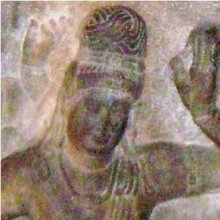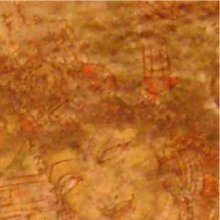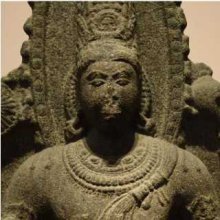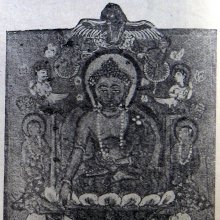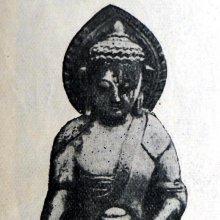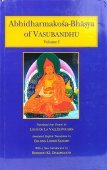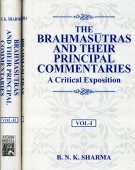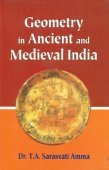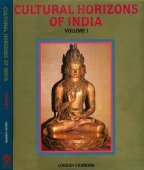Sutra, Sūtra: 42 definitions
Introduction:
Sutra means something in Buddhism, Pali, Hinduism, Sanskrit, Jainism, Prakrit, the history of ancient India, Marathi, Hindi. If you want to know the exact meaning, history, etymology or English translation of this term then check out the descriptions on this page. Add your comment or reference to a book if you want to contribute to this summary article.
Images (photo gallery)
(+2 more images available)
In Hinduism
Purana and Itihasa (epic history)
Source: Google Books: Cultural History from the Vāyu PurānaSūtra (सूत्र)—One of the Heavenly ornaments according to the Vāyu Purāṇa. The neck of Śiva, after he had swallowed the poison, shone as if it was adorned with a golden thread.
Source: archive.org: Puranic EncyclopediaSūtra (सूत्र).—(VEDASŪTRA). See under Veda.
Source: Cologne Digital Sanskrit Dictionaries: The Purana IndexSūtra (सूत्र).—(ety)—definition of: few letters, free from doubt, terse, and universal.*
- * Vāyu-purāṇa 59. 142; 104. 108.

The Purana (पुराण, purāṇas) refers to Sanskrit literature preserving ancient India’s vast cultural history, including historical legends, religious ceremonies, various arts and sciences. The eighteen mahapuranas total over 400,000 shlokas (metrical couplets) and date to at least several centuries BCE.
Natyashastra (theatrics and dramaturgy)
Source: Wisdom Library: Nāṭya-śāstraSūtra (सूत्र, “thread”) refers to a “golden neck-chain” and is classified as an ornament (ābharaṇa) for the neck (kaṇṭha) to be worn by males, according to Nāṭyaśāstra chapter 23. Such ornaments for males should be used in cases of gods and kings.
Sūtra (सूत्र) also refers to a “golden thread” ornament (ābharaṇa) for the waist (kaṭi) to be worn by males. It is to be worn below the talaka.
Sūtra (सूत्र) also refers to a “neck-chain” ornament (ābharaṇa) for the neck (kaṇṭha) to be worn by females. Such ornaments for females should be used in cases of human females and celestial beings (gods and goddesses).
Ābharaṇa (‘ornaments’, eg., sūtra) is a category of alaṃkāra, or “decorations”, which in turn is a category of nepathya, or “costumes and make-up”, the perfection of which forms the main concern of the Āhāryābhinaya, or “extraneous representation”, a critical component for a successful dramatic play.

Natyashastra (नाट्यशास्त्र, nāṭyaśāstra) refers to both the ancient Indian tradition (shastra) of performing arts, (natya—theatrics, drama, dance, music), as well as the name of a Sanskrit work dealing with these subjects. It also teaches the rules for composing Dramatic plays (nataka), construction and performance of Theater, and Poetic works (kavya).
Mīmāṃsā (school of philosophy)
Source: Srimatham: Mīmāṃsa: The Study of Hindu ExegesisSūtra (सूत्र) refers to one of the three principle styles found in Sanskrit literature.—Sūtra is a very terse form of writing in which there is no embellishment. The sentence consists of few words and no narrative, explanation or dilation. They were meant for easy memorization by students and depended upon the commentary given by learned scholars.
The sūtras require extensive commentaries and because of their ambivalence can be interpreted in a number of different ways. To this category belong all the texts of the various schools of philosophy, Mīmāṃsa-sūtras, Yoga-sūtras, Vaiśeṣika-sutras, Dharma-sūtras, Gṛhya-sūtras etc.
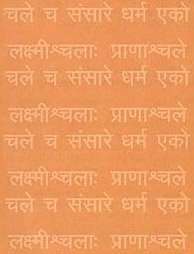
Mimamsa (मीमांसा, mīmāṃsā) refers to one of the six orthodox Hindu schools of philosophy, emphasizing the nature of dharma and the philosophy of language. The literature in this school is also known for its in-depth study of ritual actions and social duties.
Vyakarana (Sanskrit grammar)
Source: Shodhganga: Vaiyākaraṇabhūṣaṇasāra: a critical studySūtra (सूत्र).—Aphorism; a very short and concise enunciation laying down something in a scientific treatise.
Source: Wikisource: A dictionary of Sanskrit grammarSūtra (सूत्र).—A short pithy assertion laying down something in a scientific treatise; aphorism; the word is sometimes used in a collective sense in the singular, referring to the whole collection of Sutras or rules; cf. व्याकरणस्य सूत्रम् (vyākaraṇasya sūtram) M. Bh. on Ahnika 1. The term is defined as अल्पाक्षरमसंदिग्धं सारवद्विश्वतोमुखम् । अस्तो-भमनवद्यं च सूत्रं सूत्रविदो विदुः (alpākṣaramasaṃdigdhaṃ sāravadviśvatomukham | asto-bhamanavadyaṃ ca sūtraṃ sūtravido viduḥ). There are given generally six kinds of Sutras viz. संज्ञासूत्र, परिभाषासूत्र,विधिसूत्र, नियमसूत्र, प्रतिषेधसूत्र (saṃjñāsūtra, paribhāṣāsūtra, vidhisūtra, niyamasūtra, pratiṣedhasūtra) and अधिकारसूत्र (adhikārasūtra); cf. also संज्ञा च परिभाषा च विधिर्नियम एव च प्रतिषेधोधि-कारश्च षड्विधम् सूत्रलक्षणम् ॥ (saṃjñā ca paribhāṣā ca vidhirniyama eva ca pratiṣedhodhi-kāraśca ṣaḍvidham sūtralakṣaṇam ||) Com. on Kat. I. 1.2.

Vyakarana (व्याकरण, vyākaraṇa) refers to Sanskrit grammar and represents one of the six additional sciences (vedanga) to be studied along with the Vedas. Vyakarana concerns itself with the rules of Sanskrit grammar and linguistic analysis in order to establish the correct context of words and sentences.
Jyotisha (astronomy and astrology)
Source: Wikibooks (hi): Sanskrit Technical TermsSūtra (सूत्र).—A rule or algorithm; (lit., thread). Note: Sūtra is a Sanskrit technical term used in ancient Indian sciences such as Astronomy, Mathematics and Geometry.

Jyotisha (ज्योतिष, jyotiṣa or jyotish) refers to ‘astronomy’ or “Vedic astrology” and represents the fifth of the six Vedangas (additional sciences to be studied along with the Vedas). Jyotisha concerns itself with the study and prediction of the movements of celestial bodies, in order to calculate the auspicious time for rituals and ceremonies.
Kavya (poetry)
Source: archive.org: Naisadhacarita of SriharsaSūtra (सूत्र) refers to an “indication” or a “prelude”, and is mentioned in the Naiṣadha-carita 16.15.

Kavya (काव्य, kavya) refers to Sanskrit poetry, a popular ancient Indian tradition of literature. There have been many Sanskrit poets over the ages, hailing from ancient India and beyond. This topic includes mahakavya, or ‘epic poetry’ and natya, or ‘dramatic poetry’.
Shilpashastra (iconography)
Source: Shodhganga: Vaisnava Agamas And Visnu ImagesSūtra (सूत्र) refers to “decorative cords”, as defined in treatises such as the Pāñcarātra, Pādmasaṃhitā and Vaikhānasa-āgamas, extensively dealing with the technical features of temple art, iconography and architecture in Vaishnavism.—The Āgamas and Śilpa-works pay more attention to several type of bands or bandhas (kūcabandha, stanabandha, kaṭibandha, udarabandha), threads or sūtras (including the sacred cord yajñasūtra, kaṭisūtra, urassūtra/ plambasūtra etc.), girdles, strings and belts which adorn the torso (like the channavīra cross-belt), the waist and hip (mekhalā, ūrudāma, kañcīdāma etc.) down to the thighs. According to Bharata, variety of garlands set with jewels and made with artistic perfection are the ornaments of chest and jewelled strings are embellishment for the breast.
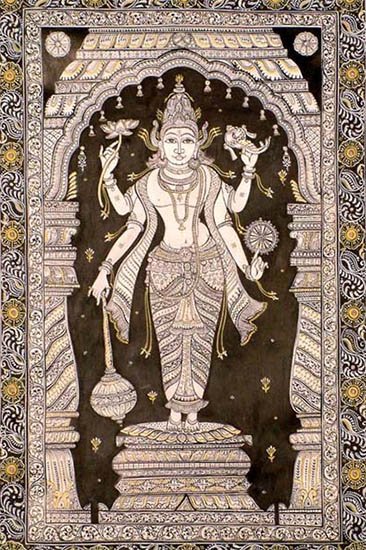
Shilpashastra (शिल्पशास्त्र, śilpaśāstra) represents the ancient Indian science (shastra) of creative arts (shilpa) such as sculpture, iconography and painting. Closely related to Vastushastra (architecture), they often share the same literature.
Ayurveda (science of life)
Agriculture (Krishi) and Vrikshayurveda (study of Plant life)
Source: Shodhganga: Drumavichitrikarnam—Plant mutagenesis in ancient IndiaSūtra (सूत्र) refers to a “thread (for tying together)” (the bulbs of Nymphaea), as prescribed by certain bio-organical recipes for plant mutagenesis, according to the Vṛkṣāyurveda by Sūrapāla (1000 CE): an encyclopedic work dealing with the study of trees and the principles of ancient Indian agriculture.—Accordingly, “If bulbs of various species of Nymphaea are uprooted tied together firmly with threads (sūtra), smeared with melted butter and honey and then planted they produce those respective species in bunches (on a single creeper). Similarly several wonders of transformation can be worked out by tying together the stems of Nerium indicum and those of various species of Punica granatum”.
Unclassified Ayurveda definitions
Source: gurumukhi.ru: Ayurveda glossary of termsSūtra (सूत्र):—[sūtraṃ] Precised form of text; Aphorism

Āyurveda (आयुर्वेद, ayurveda) is a branch of Indian science dealing with medicine, herbalism, taxology, anatomy, surgery, alchemy and related topics. Traditional practice of Āyurveda in ancient India dates back to at least the first millenium BC. Literature is commonly written in Sanskrit using various poetic metres.
Shaivism (Shaiva philosophy)
Source: Brill: Śaivism and the Tantric TraditionsSūtra (सूत्र) (or Tantu) refers to the Śaktitantu (“cord of power”), according to the Brahmayāmala-tantra (or Picumata), an early 7th century Śaiva text consisting of twelve-thousand verses.—[The padmamālā-vidhi prescribes installing deities within series of nine, seven and eight lotuses].—What renders the lotuses into garlands is the thread which binds them. The Brahmayāmala first introduces this idea in presenting the second garland (that of the Yoginīs), describing the lotuses as “bound together by the cord of śakti, like gems [strung] by a cord”. The terms utilized are śaktitantu and śaktisūtra, meaning, respectively, a thread or a cord of śakti. This divine power binding the lotuses together is consubstantial with the supreme Goddess herself, the Nine-Syllable Vidyā whose being encompasses the deities of the maṇḍala.
Source: SOAS University of London: Protective Rites in the Netra Tantra1) Sūtra (सूत्र) refers to a “cord” (of bound pearls), according to the Netratantra of Kṣemarāja: a Śaiva text from the 9th century in which Śiva (Bhairava) teaches Pārvatī topics such as metaphysics, cosmology, and soteriology.—Accordingly, [verse 2.20-22ab]—“[The Mantrin] should worship the mother of Mantras with the highest bhakti, by spreading flowers and perfume, O Devī. He should extract the deity invoked by the Mantra [with the mantra]. Beginning with the all-pervading and ending with manifold [oṃ], [he should] always [worship with] the nectar of the white flower. The bright sound is highest Śakti, [who] resembles one-in-the-same Śiva. By this [worship] the pearls [of the mantra] are all bound in a cord (sūtra—grathitaṃ sarvaṃ sūtre)”.
2) Sūtra (सूत्र) refers to the “threads (of the bonds)”, according to the Netratantroddyota commentary on the Netratantra.—Accordingly, [verse 4.4.5ab]—“[First of all, [the Mantrin] attaches the threads of the bonds (pāśa-sūtra) to the disciple’s body, then infuses the parts [of the body into that thread]. Then [the Mantrin] respectfully approaches the path (adhvan), and [performs] worship and homa to the [six] adhvans. Then, [he] visualizes the three bonds [inside the adhvans]. Then [the Mantrin performs] such rituals as the installation [of] the śakti, which is the support of everything else”.

Shaiva (शैव, śaiva) or Shaivism (śaivism) represents a tradition of Hinduism worshiping Shiva as the supreme being. Closely related to Shaktism, Shaiva literature includes a range of scriptures, including Tantras, while the root of this tradition may be traced back to the ancient Vedas.
Kama-shastra (the science of Love-making)
Source: Shodhganga: Elements of Art and Architecture in the Trtiyakhanda of the Visnudharmottarapurana (kama)Sūtra (सूत्र) refers to “yarns” or “threads”.—Cf. Sūtrakrīḍā which refers to “making models from yarns or threads”, representing one of the “sixty four kinds of Art”, according to the Kāmasūtra of Vātsyāyaṇa.—Indian tradition, basically includes sixty four Art forms are acknowledged. The references of sixty four kinds of kalā are found in the Bhāgavatapurāṇa, Śaiva-Tantras, Kāmasūtra of Vātsyāyaṇa etc.
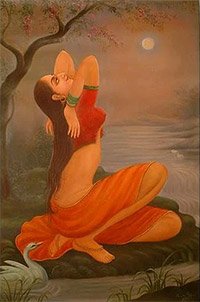
Kamashastra (कामशास्त्र, kāmaśāstra) deals with ancient Indian science of love-making, passion, emotions and other related topics dealing with the pleasures of the senses.
Yoga (school of philosophy)
Source: ORA: Amanaska (king of all yogas): A Critical Edition and Annotated Translation by Jason BirchSūtra (सूत्र) refers to the “thread (of the breath)”, according to the Amanaska Yoga treatise dealing with meditation, absorption, yogic powers and liberation.—Accordingly, as Īśvara says to Vāmadeva: “[...] When the wings, which are the in and out breaths and whose sphere of operation is all the senses, are cut off, the mind-bird being motionless [in the air], plummets. [The Yogin] becomes joyful like a fish having torn [free from] the mind-net, whose threads are the breath (śvāsa-sūtra) and whose knots are the senses. [...]”.

Yoga is originally considered a branch of Hindu philosophy (astika), but both ancient and modern Yoga combine the physical, mental and spiritual. Yoga teaches various physical techniques also known as āsanas (postures), used for various purposes (eg., meditation, contemplation, relaxation).
General definition (in Hinduism)
Source: archive.org: Vedic index of Names and SubjectsSūtra (सूत्र) has the sense of ‘thread’ in the Atharvaveda and later. In the sense of a ‘ book of rules ’ for the guidance of sacrifices and so forth, the word occurs in the Bṛhadāraṇyaka-upaniṣad (ii. 4. 10).
Source: WikiPedia: HinduismSūtra: A text in Hinduism or Buddhism. Literally it means a thread or line that holds things together and is derived from the verbal root siv-, meaning to sew, as does the medical term "suture." The word "sutra" was very likely meant to apply quite literally to these texts, as they were written down in books of palm leaves sewn together with thread. This distinguishes them from the older sacred Vedas, which until recently were only memorised, never committed to paper.
In ancient Indian literature, sutra denotes a distinct type of literary composition, based on short aphoristic statements, generally using various technical terms.
In Jainism, sūtra refers to canonical sermons of the Mahavira contained in the Jain Agamas, and to some later (post-canonical) normative texts.
In Buddhism, the sūtra refers mostly to canonical scriptures, many of which are regarded as records of the oral teachings of Gautama Buddha.
etymology: Sūtra (Sanskrit: सूत्र, Pāli: sutta, Ardhamagadhi: sūya).
In Buddhism
Mahayana (major branch of Buddhism)
Source: Wisdom Library: Maha Prajnaparamita SastraSūtra (सूत्र) refers to one of the twelve members of Buddhist texts (dvādaśāṅga), according to a note attached to the Mahāprajñāpāramitāśāstra chapter 51.—Among these texts, those that correctly (sūcanatas) express the meaning are called sūtra. These are:
- the four Āgamas,
- the Mahāyānasūtras,
- the 250 rules (śikṣāpada).
And, apart from the Tripiṭaka, there are also texts that are called sūtras.
Sūtra is the name of the sacred texts found in the four Āgamas (āgamacatuṣṭaya) and the name of the sacred texts found in the Mahāyāna. The sūtras are of two groups: the sūtras contained in the four Āgamas and the Mahāyānsūtras called Great Sūtras. To penetrate into these two groups is to penetrate into the Greater and Lesser Vehicles also. The 250 precepts (śikṣāpada) and similar texts are called ‘sūtra’.
Source: De Gruyter: A Buddhist Ritual Manual on AgricultureSūtra (सूत्र) [=sūtraka?] refers to a “(five-fold) twine” (suitable for an offering ritual), according to the Vajratuṇḍasamayakalparāja, an ancient Buddhist ritual manual on agriculture from the 5th-century (or earlier), containing various instructions for the Sangha to provide agriculture-related services to laypeople including rain-making, weather control and crop protection.—Accordingly, [as the Bhagavān teaches the offering of the root spell], “[...] Four stakes made of khadira wood should be driven into the ground in the four corners of the maṇḍala. This [space] should be encircled with five-coloured five-fold twine (sūtra). Having recited twenty-one times everywhere, a rite should be performed. [...]”.

Mahayana (महायान, mahāyāna) is a major branch of Buddhism focusing on the path of a Bodhisattva (spiritual aspirants/ enlightened beings). Extant literature is vast and primarely composed in the Sanskrit language. There are many sūtras of which some of the earliest are the various Prajñāpāramitā sūtras.
Tibetan Buddhism (Vajrayana or tantric Buddhism)
Source: archive.org: The Indian Buddhist IconographySūtra (सूत्र) refers to the “sacred thread” and represents one of the five auspicious symbols of Nairātmā.—The Indian Museum image is the only image of this goddess [Nairātmā] which conforms to the description given in the sādhana. Here the goddess, in accordance with the Dhyāna, has a terrible appearance with canine teeth, garland of heads and three eyes rolling in anger. She stands on the corpse lying on its back, and dances in the ardhaparyaṅka attitude. Burning flames radiate from her person, and her hair rise upwards in the shape of a flame. She is decked in the five auspicious symbols, the kaṇṭhikā (torque), rucaka (bracelets), ratna (jewels), mekhalā (girdle), and bhasma (ashes) or the sūtra (sacred thread) in the form of a garland of heads. She bears the image of her sire Akṣobhya on her crown and carries the menacing kartri in the right hand. The left hand holding the kapāla is broken. The khaṭvāṅga, as usual, hangs from her left shoulder.
Source: academia.edu: The Structure and Meanings of the Heruka MaṇḍalaSūtra (सूत्र) is the name of a Vīra (hero) who, together with the Ḍākinī named Sūtrikā forms one of the 36 pairs situated in the Cittacakra, according to the 10th century Ḍākārṇava chapter 15. Accordingly, the cittacakra refers to one of the three divisions of the nirmāṇa-puṭa (‘emanation layer’), situated in the Herukamaṇḍala. The 36 pairs of Ḍākinīs and Vīras [viz., Sūtra] are black in color; they each have one face and four arms; they hold a skull bowl, a skull staff, a small drum, and a knife.

Tibetan Buddhism includes schools such as Nyingma, Kadampa, Kagyu and Gelug. Their primary canon of literature is divided in two broad categories: The Kangyur, which consists of Buddha’s words, and the Tengyur, which includes commentaries from various sources. Esotericism and tantra techniques (vajrayāna) are collected indepently.
General definition (in Buddhism)
Source: Wisdom Library: Dharma-samgrahaSūtra (सूत्र, “discourses”) refers to one of the “nine (types of) teachings” (sūtra) as defined in the Dharma-saṃgraha (section 62). The Dharma-samgraha (Dharmasangraha) is an extensive glossary of Buddhist technical terms in Sanskrit (e.g., sūtra). The work is attributed to Nagarjuna who lived around the 2nd century A.D.
Source: Wisdom Library: BuddhismSutra:—A teaching or book
Source: Shambala Publications: GeneralSūtra Skt., lit., “thread”; (Pali, sutta; Jap., kyō); discourses of the Buddha. The sūtras are collected in the second part of the Buddhist canon, the Sūtra-pitaka, or “Basket of the Teachings.” According to tradition they derive directly from the Buddha. The sūtras are prose texts, each introduced by the words “Thus have I heard.” These words are ascribed to Ānanda, a student of the Buddha.
The Hīnayāna sūtras are divided into “collections,” which in the Pali canon are called Nikāyas and in the Sanskrit version, Agamas. The Nikāyas are the Dīgha-nikāya, Majjhima-nikāya, Samyutta-nikāya, Anguttara-nikāya, and Khuddaka-nikāya. Along with these Hīnayāna sūtras, a great number of Mahāyāna sūtras have also been preserved. They were originally composed in Sanskrit but are for the most part extant only in Chinese or Tibetan translations. They are thought to have been composed between the 1st century BCE and the 6th century CE.
In Jainism
General definition (in Jainism)
Source: Encyclopedia of Jainism: Tattvartha SutraSūtra (सूत्र) refers to one of the five parts of Dṛṣṭivāda: one of the twelve limbs of the internal-corpus (aṅga-praviṣṭa). The Aṅgapraviṣṭa refers to one of the two types of scriptural knowledge (śruta), which refers to one of the five types of knowledge (jñāna). according to the 2nd-century Tattvārthasūtra 1.20, “scriptural knowledge (śruta) preceded by sensory knowledge (mati) is of two, or of twelve (e.g., dṛṣṭivāda) or of many kinds”.
How may sub divisions are there of Sūtra and Prathāmanuyoga? There is only one type /part of both Sūtra and Prathāmanuyoga.

Jainism is an Indian religion of Dharma whose doctrine revolves around harmlessness (ahimsa) towards every living being. The two major branches (Digambara and Svetambara) of Jainism stimulate self-control (or, shramana, ‘self-reliance’) and spiritual development through a path of peace for the soul to progess to the ultimate goal.
India history and geography
Source: Cologne Digital Sanskrit Dictionaries: Indian Epigraphical GlossarySūtra.—(IA 20), a manual of religious rituals, etc. (HRS), royal receipts collected by the superintendent of weaving, as suggested by the Arthaśāstra. (IE 3-1), same as śarayantraka; the string holding the leaves of a manuscript together (Vāsavadatta, Hall's ed., p. 250). Note: sūtra is defined in the “Indian epigraphical glossary” as it can be found on ancient inscriptions commonly written in Sanskrit, Prakrit or Dravidian languages.
--- OR ---
Sūtra.—(PJS), abbreviation of Sūtradhāra, a mason. Note: sūtra is defined in the “Indian epigraphical glossary” as it can be found on ancient inscriptions commonly written in Sanskrit, Prakrit or Dravidian languages.

The history of India traces the identification of countries, villages, towns and other regions of India, as well as mythology, zoology, royal dynasties, rulers, tribes, local festivities and traditions and regional languages. Ancient India enjoyed religious freedom and encourages the path of Dharma, a concept common to Buddhism, Hinduism, and Jainism.
Languages of India and abroad
Marathi-English dictionary
Source: DDSA: The Molesworth Marathi and English Dictionarysutrā (सुत्रा).—& sutrī a Better sūtrā.
--- OR ---
sūtra (सूत्र).—n (S) A thread in general, any string, line, fibre, or filament. 2 The string or wire of a puppet, doll &c.; and, hence, the art, trick, mystery, knack, key, spring, turning pin (of an ingenious piece of mechanism, or a complicate and intricate business); the scheme or plan of its construction; the manner of its operation; the moving or managing principle &c.: also, for manasūtra, the inclining or working of the mind; the mental tendencies or the will. 3 The rule, law, canon; the system of instructions and directions; the process or line of procedure; as prescribed or as necessary to be observed for the accomplishment or conduct of a business or work. 4 A rule or precept (in morals or science); a short, obscure, and technical sentence, enjoining some observance in law or religion, or expressing some rule in grammar, logic, or other science. In both cases, the sutra is the fundamental and primitive part of Hindu learning, and is the form in which the works of the early writers appear. 5 An opinion or a decree in law. 6 A string; a collection of threads (as that worn over the shoulder by the three first classes).
--- OR ---
sūtrā (सूत्रा) [or सूत्री, sūtrī].—a The same with sūtraka q. v. supra; but sūtrā being more definitely Prakrit, and determined somewhat by the Hindustani has the further sense of Clever, expert, adroit, skilful, sharp, smart, apt &c.
Source: DDSA: The Aryabhusan school dictionary, Marathi-Englishsūtra (सूत्र).—n A thread. The key. A rule. A string.
Marathi is an Indo-European language having over 70 million native speakers people in (predominantly) Maharashtra India. Marathi, like many other Indo-Aryan languages, evolved from early forms of Prakrit, which itself is a subset of Sanskrit, one of the most ancient languages of the world.
Sanskrit dictionary
Source: DDSA: The practical Sanskrit-English dictionarySūtra (सूत्र).—[sūtr-ac]
1) A thread, string, line, cord; पुष्पमालानुषङ्गेण सूत्रं शिरसि धार्यते (puṣpamālānuṣaṅgeṇa sūtraṃ śirasi dhāryate) Subhās.; मणौ वज्रसमुत्कीर्णे सूत्रस्येवास्ति मे गतिः (maṇau vajrasamutkīrṇe sūtrasyevāsti me gatiḥ) R.1.4.
2) A fibre; सुराङ्गना कर्षति खण्डिताग्रात् सूत्रं मृणालादिव राजहंसी (surāṅganā karṣati khaṇḍitāgrāt sūtraṃ mṛṇālādiva rājahaṃsī) V.1.18; Kumārasambhava 1.4.
3) A wire.
4) A collection of threads.
5) The sacred thread or sacrificial cord worn by members of the first three classes; शिखासूत्रवान् ब्राह्मणः (śikhāsūtravān brāhmaṇaḥ) Tarka K.; विप्रत्वे सूत्रमेव हि (vipratve sūtrameva hi) Bhāgavata 12.2.3.
6) The string or wire of a puppet.
7) A short rule or precept, an aphorism.
8) A short or concise technical sentence used as a memorial rule; it is thus defined:-स्वल्पाक्षरमसंदिग्धं सारवद् विश्वतोमुखम् । अस्तोभमनवद्यं च सूत्रं सूत्रविदो विदुः (svalpākṣaramasaṃdigdhaṃ sāravad viśvatomukham | astobhamanavadyaṃ ca sūtraṃ sūtravido viduḥ).
9) Any work or manual containing such aphoristic rules; e. g. मानवकल्पसूत्र, आपस्तम्बसूत्र, गृह्यसूत्र (mānavakalpasūtra, āpastambasūtra, gṛhyasūtra) &c.
1) A rule, canon, decree (in law).
11) A girdle; वासः ससूत्रं लघुमारुतोऽहरद् भवस्य देवस्य किलानुपश्यतः (vāsaḥ sasūtraṃ laghumāruto'harad bhavasya devasya kilānupaśyataḥ) Bhāgavata 8.12.23.
12) A line, stroke.
13) A sketch, plan; त्वमेव धर्मार्थदुघाभिपत्तये दक्षेण सूत्रेण ससर्जिथा- ध्वरम् (tvameva dharmārthadughābhipattaye dakṣeṇa sūtreṇa sasarjithā- dhvaram) Bhāgavata 4.6.44.
14) Indication, prelude; विशङ्क्य सूत्रं पुरुषायितस्य तद् भविष्यतोऽस्मायि तदा तदालिभिः (viśaṅkya sūtraṃ puruṣāyitasya tad bhaviṣyato'smāyi tadā tadālibhiḥ) N.16.15.
Derivable forms: sūtram (सूत्रम्).
Source: Cologne Digital Sanskrit Dictionaries: Edgerton Buddhist Hybrid Sanskrit DictionarySūtra (सूत्र).—nt. (also sūtrānta, q.v.), (1) (= Pali sutta) discourse, as a type of Buddhist sacred text (pravacana), one of twelve, Mahāvyutpatti 1267, or nine, Dharmasaṃgraha 62; (2) also = sūtra-piṭaka, q.v. (= Pali sutta-piṭaka), the (collection of) discourses, one of the three grand divisions of the Buddhist canon: Mahāvyutpatti 1412; Divyāvadāna 333.7; sūtravinayābhi- dharmeṇa Laṅkāvatāra-sūtra 290.8.
Source: Cologne Digital Sanskrit Dictionaries: Shabda-Sagara Sanskrit-English DictionarySūtra (सूत्र).—n.
(-traṃ) 1. A thread in general. 2. A rule, a precept, in morals or science; a short, obscure, and technical sentence, enjoying some observance in law or religion, or intimating some rule in grammar, logic, &c.; in each case it is the fundamental and primitive part of Hindu learning, and is the form in which the works of the early and supposed inspired writers appear; the ingenuity and labour of subsequent authors having expanded and explained the original Sutras in various commentaries and glosses. 3. An opinion or decree, (in law.) 4. A string, a collection of threads, as that worn by the three first classes, &c. 5. The string or wire of a puppet. 6. A fibre. E. ṣiv to sew, ṣṭran Unadi aff., and iva changed to ū; or sūtra to string, ac aff.
Source: Cologne Digital Sanskrit Dictionaries: Benfey Sanskrit-English DictionarySūtra (सूत्र).—i. e. siv + tra, n. 1. A thread, [Hitopadeśa] 65, 13. 2. Fibre, [Vikramorvaśī, (ed. Bollensen.)] [distich] 19. 3. A string, [Vikramorvaśī, (ed. Bollensen.)] [distich] 140; the holy string, [distich] 157. 4. A rule in morals or science, a short aphorism, e. g. the rules of Pāṇini. 5. An opinion or decree in law.
Source: Cologne Digital Sanskrit Dictionaries: Cappeller Sanskrit-English DictionarySūtra (सूत्र).—[neuter] thread, cord, [especially] the sacred cord worn by the first three classes; string, wire; line, brief rule or a book of such rules.
Source: Cologne Digital Sanskrit Dictionaries: Aufrecht Catalogus CatalogorumSūtra (सूत्र) as mentioned in Aufrecht’s Catalogus Catalogorum:—[anonymous] Oppert. 4673.
Source: Cologne Digital Sanskrit Dictionaries: Monier-Williams Sanskrit-English Dictionary1) Sūtra (सूत्र):—[from sūtr] n. ([according to] to [gana] ardhacādi also m.; [from] √siv, ‘to sew’, and connected with sūci and sūnā) a thread, yarn, string, line, cord, wire, [Atharva-veda] etc. etc.
2) [v.s. ...] a measuring line (cf. -pāta), [Harivaṃśa; Varāha-mihira’s Bṛhat-saṃhitā] etc.
3) [v.s. ...] the sacred thread or cord worn by the first three classes (cf. yajñopavīta), [Bhāgavata-purāṇa]
4) [v.s. ...] a girdle, [ib.]
5) [v.s. ...] a fibre, [Kālidāsa]
6) [v.s. ...] a line, stroke, [Mahābhārata; Varāha-mihira’s Bṛhat-saṃhitā; Golādhyāya]
7) [v.s. ...] a sketch, plan, [Rājataraṅgiṇī]
8) [v.s. ...] that which like a thread runs through or holds together everything, rule, direction, [Bhāgavata-purāṇa]
9) [v.s. ...] a short sentence or aphoristic rule, and any work or manual consisting of strings of such rules hanging together like threads (these Sūtra works form manuals of teaching in ritual, philosophy, grammar etc.: e.g. in ritual there are first the Śrauta-sūtras, and among them the Kalpa-sūtras, founded directly on Śruti q.v.; they form a kind of rubric to Vedic ceremonial, giving concise rules for the performance of every kind of sacrifice [Indian Wisdom, by Sir M. Monier-Williams 146 etc.]; other kinds of Ś° works are the Gṛhya-sūtras and Sāmayācārika or Dharma-sūtras id est. ‘rules for domestic ceremonies and conventional customs’, sometimes called collectively Smārta-sūtras [as founded on smṛti or ‘tradition’ See smārta]; these led to the later Dharmaśāstras or ‘law-books’ [Indian Wisdom, by Sir M. Monier-Williams 145]; in philosophy each system has its regular text-book of aphorisms written in Sūtras by its supposed founder [Indian Wisdom, by Sir M. Monier-Williams 60 etc.]; in Vyākaraṇa or grammar there are the celebrated Sūtras of Pāṇini in eight books, which are the groundwork of a vast grammatical literature; with Buddhists, Pāśupatas etc. the term Sūtra is applied to original text books as opp. to explanatory works; with Jainas they form part of the Dṛṣṭivāda), [Indian Wisdom, by Sir M. Monier-Williams 162 etc.]
10) [v.s. ...] a kind of tree, [Divyāvadāna]
Source: Cologne Digital Sanskrit Dictionaries: Yates Sanskrit-English Dictionary1) Sūtra (सूत्र):—(kat) sūtrayati 10. a. To thread, string.
2) (traṃ) 1. n. A thread, a Brāhmanical thread; a line; verse, text; rule; decree of law.
Source: DDSA: Paia-sadda-mahannavo; a comprehensive Prakrit Hindi dictionary (S)Sūtra (सूत्र) in the Sanskrit language is related to the Prakrit word: Sutta.
[Sanskrit to German]
Sanskrit, also spelled संस्कृतम् (saṃskṛtam), is an ancient language of India commonly seen as the grandmother of the Indo-European language family (even English!). Closely allied with Prakrit and Pali, Sanskrit is more exhaustive in both grammar and terms and has the most extensive collection of literature in the world, greatly surpassing its sister-languages Greek and Latin.
Hindi dictionary
Source: DDSA: A practical Hindi-English dictionarySūtra (सूत्र):—(nm) a thread, yarn, fibre; source; aphorism; formula; sacred thread ([janeū; ~kartā]) a composer of aphorism (of philosophy, grammar, etc.); ~[dhāra] the stage manager (in a dramatic performance); ~[pāta] beginning, commencement: ~[baddha] formulated; integrated; -[śailī] terse style, condensed style.
...
Kannada-English dictionary
Source: Alar: Kannada-English corpusSūtra (ಸೂತ್ರ):—
1) [noun] a length of a thread.
2) [noun] a sacrificial thread worn on the left shoulder and under the right arm by brāhmaṇas.
3) [noun] a string or strings used to make the puppets.
4) [noun] a short, pointed sentence or verse expressing a wise, esoteric observation, truth, etc.; an aphorism.
5) [noun] a law, rule or other order prescribed by authority; a regulation.
6) [noun] a controlling or being controlled.
7) [noun] (math.) a symbol for the number two.
8) [noun] ಸೂತ್ರದ ಗೊಂಬೆ [sutrada gombe] sūtrada gombe a puppet or jointed figure moved by pulling the strings attached to it; 2. (fig.) a person whose actions, ideas, etc. are controlled by another; a puppet; ಸೂತ್ರ ಆಡಿಸು [sutra adisu] sūtraāḍisu to pull the strngs manipulatively while playing the dolls on the stage; 2. ( fig.) to direct action of others secretely; ಸೂತ್ರ ಹಿಡಿ [sutra hidi] sūtra hiḍi = ಸೂತ್ರ ಆಡಿಸು [sutra adisu].
Kannada is a Dravidian language (as opposed to the Indo-European language family) mainly spoken in the southwestern region of India.
See also (Relevant definitions)
Starts with (+119): Shutran, Sutra-sancalaka, Sutrabaddha, Sutrabaddhate, Sutrabandha, Sutrabhashya, Sutrabhashyavyakhya, Sutrabheda, Sutrabhid, Sutrabhrit, Sutrabombe, Sutracarana, Sutraccheda, Sutracharana, Sutradanda, Sutradaridra, Sutradaridrata, Sutradhara, Sutradhara-pitamaha, Sutradharaka.
Ends with (+624): Adhanasutra, Adhikarasutra, Adhishthanasutra, Adhvaryusutra, Adhyashayasamchodanasutra, Adhyashayasamcodanasutra, Adhyatmikasutra, Adirghasutra, Adisutra, Advaitasarasvatasutra, Agama Sutra, Aghasamshayatimiradityasutra, Aghikarasutra, Agnihotrasutra, Agnisutra, Agratasutra, Agrayanasutra, Aikyasutra, Akshasutra, Akshayamatisutra.
Full-text (+16201): Brahmasutra, Avatamsaka Sutra, Shrautasutra, Sautra, Bhashya, Kalpasutra, Manasutra, Mandukagati, Hastasutra, Yajnaparibhasha, Mahabhashya, Sutram, Vimalakirti, Mimamsa Sutra, Patanjali, Dharmasutra, Sutrayantra, Sutradhara, Kashyapamatanga, Heart Sutra.
Relevant text
Search found 313 books and stories containing Sutra, Sūtra, Sutrā, Sūtrā; (plurals include: Sutras, Sūtras, Sutrās, Sūtrās). You can also click to the full overview containing English textual excerpts. Below are direct links for the most relevant articles:
Brahma Sutras (Shankaracharya) (by George Thibaut)
First Adhyāya < [Introduction]
Third Adhyāya < [Introduction]
Maha Prajnaparamita Sastra (by Gelongma Karma Migme Chödrön)
First aṅga (member): Sūtra < [Part 2 - Hearing the twelve-membered speech of the Buddha]
Conditions note (1): The system in the canonical sūtras < [Part 1 - Understanding the Conditions (pratyaya)]
Part 2 - Hearing the twelve-membered speech of the Buddha < [Chapter LI - Seeing all the Buddha Fields]
Jainism and Patanjali Yoga (Comparative Study) (by Deepak bagadia)
Part 2 - The History of Indian Philosophy (theoretical background) < [Chapter 1 - Introduction]
Part 5.4 - Cheda-sutras, Chulika-sutras and Mula-sutras < [Chapter 3 - Jain Philosophy and Practice]
Part 6 - Literature (comparing Yoga and Jainism < [Chapter 4 - A Comparative Study]
Dhyana in the Buddhist Literature (by Truong Thi Thuy La)
3.2 (c): The Dhyāna in the Avataṃsaka-sūtra (Hua-Yen) < [Chapter 3 - The Dhyāna in Mahāyāna Literature]
3.2 (a): The Dhyāna in the Laṅkāvatāra sūtra < [Chapter 3 - The Dhyāna in Mahāyāna Literature]
3.2 (b): The Dhyāna in the Prajñāpāramitā-sūtra < [Chapter 3 - The Dhyāna in Mahāyāna Literature]
Garga Samhita (English) (by Danavir Goswami)
Verse 5.4.25 < [Chapter 4 - The Journey to Śrī Mathurā]
Verse 1.12.25 < [Chapter 12 - Description of Śrī Nanda’s Festival]
Verse 2.15.33 < [Chapter 15 - Description of Śrī Rādhā-Kṛṣṇa’s Falling in Love]
Vakyapadiya of Bhartrihari (by K. A. Subramania Iyer)
Verse 3.14.561 < [Book 3 - Pada-kāṇḍa (14): Vṛtti-samuddeśa (On Ccomplex Formation)]
Verse 1.60 < [Book 1 - Brahma-kāṇḍa (or Āgama-samuccaya)]
Verse 3.14.463 < [Book 3 - Pada-kāṇḍa (14): Vṛtti-samuddeśa (On Ccomplex Formation)]
Related products
(+12 more products available)
